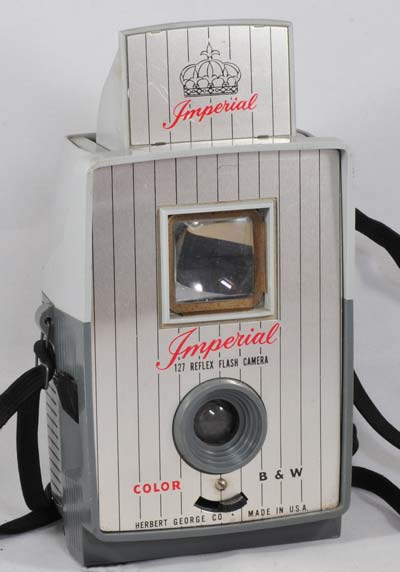Herbert George Imperial 127 Reflex Flash
Specification

| Manufacturer | : | Herbert George |
|---|---|---|
| Produced | : | 1959 |
| Classification | : | Medium Format |
| Body Type | : | Pseudo Twin Lens Reflex |
| Construction | : | Plastic |
| Film Type | : | 127 |
| Film Width | : | 46mm |
| Image Size | : | 1⅝ x 1⅝ in (4x4 cm) |
| No. of Images | : | 12 |
| Lens Type | : | Standard |
| Focal Length | : | 45mm |
| Focus Type | : | Fixed |
| Focus Range | : | 5ft to inf, |
| Aperture Type | : | Variable |
| Aperture | : | f/11(COLOR), f/16(B&W) |
| Shutter Type | : | Rotary |
| Shutter Speeds | : | I*(1/60 sec) |
| Size Open (w x h x d) | : | 95 x 60 x 163 mm |
| Size Closed (w x h x d) | : | 95 x 60 x 128 mm |
| Weight | : | 267g |
| * measured on this camera | ||
Art Deco Credentials
![]()
![]()
![]()
Noteworthy: Worth giving special attention
- Produced after the main Art Deco period;
- Curved Streamline Moderne design
- Plastic body with aluminium faceplate
- Vertical black lines on faceplate
- Vertical black lines on viewfinder cover
- Crown detailing on viewfinder cover
- Red script lettering
- Horizontal ribbed detailing to the side and back
Description
The Imperial 127 Reflex Flash is a pseudo TLR from Herbert George of Chicago, Illinois, USA. It was designed for 127 roll film, giving twelve exposures of 4x4 cm per roll.
It has a large bright viewfinder on the top with a cover which folds down when not in use. The red window on the rear does not have a cover.
A lever on the back is used to open the back to insert the film.
The lens is fixed focus and the only exposure control is the "COLOR/B&W" lever below the lens. The COLOR setting is f/11 and the B/W setting is f/16.
It has a fixed instantaneos shutter speed of 1/60 sec.
There is no tripod socket.
How to Use
This camera takes 127 film which is still available from select outlets - search for 'Rera Pan 100-127' which is a black & white film. For those photographers in the UK, try Nick & Trick photographic services. If you want to use a particular type of film which is not available commercially, then you can cut your own 127 film from any 120 film. See my page on 'How to cut 127 film from 120 film'.
If you don't want to bother with an exposure meter, follow the guide shown. It is based on the 'Sunny 16' rule. Film is so forgiving and will produce acceptable results even when overexposed by 2 or 3 stops or underexposed by 1 stop.
Remember that the exposure guide in the camera user manual may not be helpful as it is based on the use of old film with a low ISO value.
The table assumes that the sun is at least 30 degrees above the horizon - that's 10am - 5pm on a summer's day in the UK.
This camera has the choice of two apertures of f/11(COLOR) and f/16(B&W). With modern film ignore the COLOR/B&W nomenclature and just use the switch to select f/11 or f/16.
As the shutter speed is only 1/60s, it is advisable to use a tripod or to hold the camera against a wall or other solid object. For quick snapshots, hold it firmly against your body.
Using ISO 100/125 film - shutter speed 1/60s
| Weather Conditions | Shadow Detail | Aperture | Exposure |
|---|---|---|---|
 Sunny SunnySnow/Sand | Dark with sharp edges | f/16 | +2 Stop Overexposed Acceptable |
 Sunny Sunny | Distinct | f/16 | +1 Stop Overexposed Acceptable |
 Slight Overcast Slight Overcast | Soft around edges | f/16 | Good |
 Overcast Overcast | Barely visible | f/11 | Good |
 Heavy Overcast Heavy Overcast | None | f/11 | -1 Stop Underexposed Acceptable |
 Open Shade Open Shade/Sunset | None | f/11 | -2 Stop Underexposed Unacceptable |